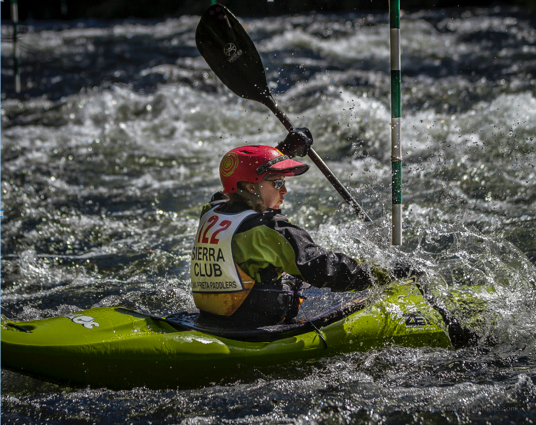Making the Moves with Whitewater Slalom
Two Strokes Forward. . . .
Two strokes forward, then three hard back strokes to pass through Gate 9, lined up for Gate 10. What am I doing? I’m kayaking a whitewater slalom course. When I first watched whitewater slalom I was impressed by how graceful and effortless it appeared. Once I tried it myself, I realized looks could be deceiving.
What is Whitewater Slalom?
Whitewater slalom is a competitive sport with the aim to navigate a canoe or kayak through a course of hanging downstream or upstream gates on river rapids in the fastest time possible. (Source: Wikipedia https://en.wikipedia.org/wiki/Whitewater_slalom)
[Author, Donna Weber, focuses on precise technique to make the gates. Photo credit: sagephotographystudio.com]
A slalom course is made up of numbered gates hanging from ropes stretched across a river. You paddle your kayak through the gates in the right order, and in the right direction, from the start to the finish line. Your score is the total number of seconds for your run, plus two penalty points for each gate touched, and 50 penalty points for each gate missed. Each slalom gate has a crossbar, a gate number and two striped poles. With two types of gates, downstream and upstream, downstream gates are marked with green striped poles and upstream gates use red striped poles. (Source: mokeraces.com)
Why Slalom?
Why bother navigating around green and red gates? When I first learned about slalom, I didn’t see the point. I was more interested in running rivers. It seemed tedious and not nearly as fun as paddling rapids.
However, going downriver generally means that you run each rapid just once. It’s a rare privilege to repeat a run and fine-tune each pass through a rapid.
Slalom, on the other hand, gives you that option. You run the gates again and again to master the section. It can be rewarding and maddening. After I tried it a few times, I was hooked.
Working slalom gates is a great opportunity to improve your paddling skills and techniques on easier water. It’s a valuable way to practice ‘must-make moves’ without consequences.
Tom Long, one of my kayak coaches, leveraged slalom when he taught his three sons kayaking As their paddling improved, he didn’t want them on harder and higher consequence rapids. Instead, he had them paddling slalom courses to keep challenging and improving their skills in a safe way. This led to competitions all across North America and Europe – building their skill sets while keeping them engaged and excited about progressing in the sport.
What Difference Does it Make?
The first year I did the Moke Races, I was amazed to win the novice women’s category! I was never athletic, and somehow as an adult, I was a winner! I couldn’t believe it.
Last month, I paddled in the Women’s Expert B category, after winning the Intermediate group a couple of years ago. I came in second (out of two), but my real accomplishment was that I made all the gates in both of my two runs.
I was out of shape this year due to a major foot surgery, so I knew that I wouldn’t be fast. But with slalom, fast isn’t always the best approach; if you miss a gate you add 50 seconds to your time.
Instead, I focused on the technical aspects of the course. I analyzed the river features and determined how to use the water to best reach and clear each gate. I took my time, even resting in the eddies at the upriver gates, and was powerful and precise. I felt so proud of myself!
Now I use my slalom experience whenever I paddle downriver. I ask myself how to leverage the river features to get to the next eddy. With slalom, it’s important to set up one or two gates upriver. I use this approach to help me set up on the river. I can be powerful and precise and work on my must-make moves. For example, when I paddle Troublemaker (the most challenging rapid on the South Fork American), it helps me to imagine that there are downriver gates just after the hole, and then on the side of Gunsight. These help me to remember to set up early for my next move.
[Smooth sailing to the left of “Gunsight” & a seamless transition to downriver. Photo credit: Lydia Martin]
Where to Slalom in California?
There are several places to check out slalom kayaking. Loma Prieta Paddlers (Bay-Area based whitewater kayak club) http://www.lomaprietapaddlers.org puts on two races each year: Cache Creek http://cachecreekraces.blogspot.com races in the Spring, and the Moke Races http://mokeraces.com in the Fall. Above Chili Bar is a slalom course at the Nugget, talk to the River Store if you want an annual membership to practice there. There are occasional clinics and races at the Nugget as well.
There is also a short slalom course at the Feather River Fest in September, and the Kern River in the Spring http://kernfestival.com. I have paddled all the courses but the Kern.
The Moke Races is a great event – it’s an accessible and interesting course and a very supportive crowd. Around 50-70 people from all over the California, Nevada and Oregon show up to race on the 18-21 gates spread out over about 300 yards of class II whitewater on the Mokelumne River in Jackson. Everyone from first time, paddlers in inflatable kayaks, to well experienced Eastern Europeans in kevlar slalom boats appear; but most paddle their river boats. I learn so much each time because everyone helps each other to improve. Also, you get to participate. You can arrive early on Friday to help put up the course up, then practice the course on Saturday. On Sunday, if you race, you are assigned to a judging station. Stations are set up along the course to time and judge touched and missed gates. After the race you can pitch-in to take down the course. Every year it amazes me that after all the sweat and hard work, once the gates are down, it’s a simple river again.
The skills I learned judging at amateur slalom events gave me an amazing opportunity last May. My husband and I had the privilege to help judge the Kayak Slalom Olympic trials in Oklahoma City! It was a fantastic experience to be a part of.
[Stoked to be judging the gates at the Olympic Trials in OKC.]
Check out paddling gates in the near future. You don’t need a fancy slalom kayak, just a lot of patience. Throw yourself into one of the events above and see how it’s fun and improves your paddling.
Author & California Native, Donna Weber, initially learned to paddle in the UK. She currently lives with her husband in Palo Alto, working as a consultant for software companies & will be using her slalom skills for an upcoming whitewater kayaking trip in Chile.
All words and images copyright California Women’s Watersport Collective 2016. All rights reserved.







